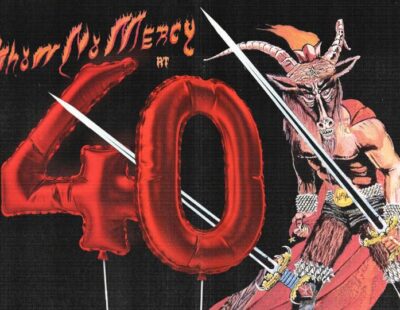
illustration by Mike Wohlberg, tFk!
The following is guest column written by Jeffrey S Podoshen, Ph.D. Associate Professor, Business, Organizations & Society at Franklin and Marshall College.
A short number of years ago Audrey Ewell and the late Aaron Aites crafted the documentary film Until the Light Takes Us, which gave an inside look at the artistry and controversies of Norwegian black metal. While there are many memorable scenes (and some scenes people would like to forget) the sequence of Frost’s performance art always stood out to me. It is gut-wrenchingly impactful and I actually use that particular footage as a key discussion prompt in my “Evil, Death and Dystopia” course at my liberal arts college. For the uninitiated, Frost engages in a performance piece composed with Bjarne Melgaard that they call, “Kill Me Before I Do it Myself.” In a profoundly angry display, Frost, mere inches from the audience, engages in aggressive torching of the set, destructive stabbing of furniture and outright overt blasphemy. As viewers watch burning embers rapidly descend from the exhibit’s structure and experience Frost destroying a multitude of items, they have only seconds to prepare to watch as Frost uses a menacingly long knife to slit his arm vertically from wrist to elbow. He then follows suit on his neck. The audience, clearly in shock, is not entirely sure if they are witnessing an actual suicide and they stand in silence as Frost reclines down, eyes open, with blood oozing out of multiple sites in his body. Aites and Ewell edit in a moment with Frost before the performance where he succinctly explains, “I have no problems being self-destructive if the whole thing is something that I like.”
Extreme metal is art. It is dangerous art and part of its very appeal is indeed that of peril and endangerment. In fact, at many shows, one might come face to face with an artist or two (or fan for that matter) who has spent significant in time in prison for offenses that range from assault to arson to murder. That is the reality of extreme metal. Most art that provokes and challenges the individual isn’t safe. This is deliberate in artistic formulation. In recent months, however, a number of members of the scene, often described as Social Justice Warriors (or SJWs), have infiltrated extreme music to push self-serving agendas under the banner of “inclusion” and “safety” going so far to call out those they oppose with the use of incessant signal boosting in social media in order to slam the door on free artistic expression. Many of these folks fall into the “scene tourist” category, merely moving from scene to scene with the stated goal of increasing diversity—yet are closely appended to a myriad of politicking activities. The ultimate goal for many of these individuals is to cleanse the scene of the aspects they find objectionable, congratulate themselves and move on… with a maybe a promotion or three towards their blogs, zines, books, politics and events.
I read Neill Jameson’s last column with particular interest for many reasons, not the least of which is that I venture out to see Taake and Young and in the Way, quite literally, any time I can. But more so, Neill sheds light on a serious problem we have in extreme music scenes and that is the growing clamor for the end to free speech and free expression. These self-annointed Social Justice Warriors, who attempt to shutdown shows, boycott bands and record companies, and besmirch artists and promoters have, somewhat ironically, adopted a variety of manipulative tactics to ensure that their narrative is out front and that all competing narratives be eradicated or merely cease to exist in the public discourse. This, of course, harkens the metal community back to the days of Tipper Gore and the PMRC, whose goal it was to make music “safer” for the masses, when the reality was that the PMRC was really involved in furthering their own political agendas and careers outside of art. A key difference this time around is that instead of using the excuse that the music is “filthy” (yes, the actual term the PMRC used), they argue that the music contains barriers to a variety of “vulnerable” people. Those who have been in the extreme music scene (short of NSBM and the like) for the past number of decades know much of the criticism of extreme music being “closed off” to particular groups of people is simply neither an accurate nor fair representation.
The reality today, of course, is that Taake is not safe. Hoest and co. have always embraced the freedom that comes with producing extreme art and, like many great artists, leave much of the interpretation up to the listener. The same can be said for Gorgoroth, 1349 and many artists who push boundaries to make an impact—even if that impact is one that makes the listener uncomfortable or “unsafe.” The actuality is that extreme metal reflects the world we live in. The world we live in is unsafe and extreme events happen, often without trigger warnings and without a place to run to. Like all utopian, socialist-driven paradises, the ending always turns out to be more Jorg Buttregeit and much less Walt Disney. The extreme metal scene must continue to challenge, push boundaries and promote itself organically lest it become a sanitized relic of a more expressive age in the self-promoting fascism of the new hard left.
The opinions, beliefs and viewpoints expressed by the author do not necessarily reflect the opinions, beliefs and viewpoints of any academic institution or organization the author is affiliated with.






